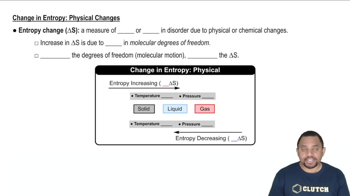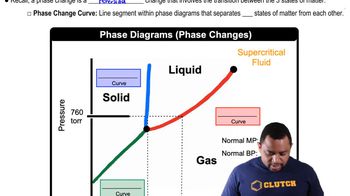Use the phase diagram of neon to answer the following questions. (a) What is the approximate value of the normal boiling point?
In terms of the arrangement and freedom of motion of the molecules, how are the nematic liquid crystalline phase and an ordinary liquid phase similar? How are they different?
 Verified step by step guidance
Verified step by step guidanceKey Concepts
Molecular Arrangement

Freedom of Motion

Phase Behavior

Use the phase diagram of neon to answer the following questions. (b) What can you say about the strength of the intermolecular forces in neon and argon based on the critical points of Ne and Ar (see Table 11.5.)?
At 25°C gallium is a solid with a density of 5.91 g/cm3 and a melting point, 29.8°C, just slightly above room temperature. The density of liquid gallium just above the melting point is 6.1 g/cm3. Based on this information, what unusual feature would you expect to find in the phase diagram of gallium?
Indicate whether each statement is true or false: (c) Molecules that exhibit a liquid crystalline phase do so at well-defined temperatures and pressures.
In all four liquid crystalline phases shown in Figure 11.32, the long axis of the molecule preferentially orders along one or more specific directions. In three of the four phases the molecules also lose some freedom of translational motion. In which of the four liquid crystalline phases do the molecules retain the freedom to move in all three directions that they possess in the liquid phase: nematic, smectic A, smectic C, or cholesteric?
